Connecticut
Bigfoot heard ‘screaming,’ ‘whooping’ in Connecticut Sasquatch hotspot

He was only showing off his wild side.
Bigfoot was caught making a ruckus in Connecticut’s Sasquatch hotspot last year, according to a recent report by The Bigfoot Field Research Organization.
A Fairfield County resident heard the hairy giant’s “screaming/long-duration whooping” just after midnight on Oct. 17, 2023 — sparking a barking dog frenzy and sending owls into a terrified silence.
“This voice had quite a bit of ‘power’ behind it and I could tell that it was carried over distance. I would ‘rough’ guesstimate at least two clicks [1.25 miles] from my coords,” the anonymous witness said in the report, which was published this summer.
The Yowie howls emitted from a forested area near the town of Monroe and lasted up to 10 terrifying minutes, according to the witness.
The alleged Bigfoot would yelp for roughly 10 seconds and halt before repeating the pattern — which the reporter claims matches other Sasquatch recordings captured and shared on YouTube.
“All the dogs in the area started barking at once when the vocalizations ended. Normally there are many owls in the area and when I had gone outside previously I could hear them,” the witness stated, adding that they were certain the noises did not come from a coyote, bobcat, cougar or fox.
“When I had noticed the vocalizations had ended it was probably a good ten minutes before I could hear the owls again.”
According to BFRO investigator and founder Matthew Moneymaker, the report wasn’t shared for nearly a year because it was a sound-only report — but a probe found the claims credible enough to land a Class B categorization.
The incident occurred with close proximity to a railroad bed and powering route that extends to locations of other sightings — including one from February 2022 in which a woman allegedly saw a “very tall large all-black upright figure” chasing 30 deer through her backyard in Bethel.
“My first thought was this is either a person or a bigfoot. I did a quick checklist in my head and ruled out person,” the witness said.
“It was solid black from head to toe with no color differences. It was also too large to be a person. I had a size comparison with the deer ran just past it. The black figure was about 2 and a half times the height of the deer torso. It must have been between 8 and 10 feet tall.”
Moneymaker said the October 2023 incident was deemed credible after ruling that species known in the area would not have been able to emit the “strange unidentified sound” that was reported.
“I contacted the witness to make sure the person was real and whether more of the sounds were heard at the location,” Monekymaker told The Post.
“He heard a loud howling sound that is distinct from other animals, but consistent with a bigfoot. It happened in an area with a history of sightings extending back decades. The area has the main ingredient present at other sighting locations: An abundance of deer in the area.”
The sighting marks the fifth Sasquatch sighting in Fairfield County since 1953.
Connecticut is seemingly a playground for Sasquatches, with 25 total sightings reported over the past seven decades, according to BFRO.
Litchfield has the most sightings of any county with 11, the most recent of which occurred in the summer of 2022.
A retired police officer reported hearing roars and yips in a similar, repetitive pattern to what the Fairfield County resident would describe just over a year later.

Connecticut
2 Powerball tickets sold in Connecticut won $50,000

There were two $50,000 Powerball winning tickets sold in Connecticut for Monday’s drawing.
The winning numbers were 23-35-59-63-68 and the Powerball was 2.
The Powerplay was X4, but neither ticket had that option.
The tickets matched four white balls and the Powerball.
No information was available on where it was sold.
No one won the jackpot on Monday night, sending it soaring to $1.25 billion for Wednesday’s drawing.
Connecticut
Opinion: Flavored vapes and Connecticut’s youth: a call for action

My generation grew up thinking we would be the ones to bring teen smoking to an end. But then came the cotton candy vapes.
They were, and still are, everywhere you look. Back in middle and high school, I remember friends had them in their backpacks and hoodie sleeves, they even used them in the school bathrooms.
This past summer, I witnessed firsthand the real impact it has had. My friends and I took a girls’ trip, and one day, we decided we wanted to blow up a pool floatie. Given that we didn’t have an air pump, the only option was to do it manually. One of my friends, who has vaped regularly for years, couldn’t get more than three breaths in before giving up. She began coughing and ran out of breath. It was funny for a second…until it wasn’t.
This was the moment that made me realize how this epidemic is hurting the people closest to us.
When e-cigarettes first hit the market, companies claimed that they were safer than smoking real cigarettes and that they would help adults quit smoking, when in reality, they’ve only really done the opposite for young people. Vaping may look harmless because of the fun flavors, names, and colors on the packaging, but the reality of it is way darker. E-cigarette use can lead to cardiovascular disease, neurological disorders, and even long term damage to the airways that can make something as simple as inhaling a serious struggle. These devices push harmful chemicals deep into young people’s lungs, disrupting their bodies in ways they’re not even aware of until it’s too late.
A Yale-led study found that one in four Connecticut high school students and one in 30 middle schoolers had already tried vaping. This may not seem like much at first glance, but the fact of the matter is that a vast majority of adolescents know at least one peer who vapes, at the very minimum. A large portion of the teens from the study preferred sweet and fruity flavors, and many students who had never smoked cigarettes before began experimenting with nicotine through vapes, which demonstrates that flavored e-cigarettes are a gateway, not a solution.

The problem is not just about curiosity. The brain is not finished developing until about age 25. This time is critical in the development of areas like attention, memory, and decision making. The CDC mentions that nicotine exposure during these earlier years of development can impair brain chemistry, having outcomes that linger into adulthood.
Despite this, vape companies continue to sell what seems like nicotine candy to minors, disguised in bright packaging and flavors like “blue razz” or “mango blast.” When you think about it, it makes sense that as soon as companies began seeing a decline in sales, they had to figure out a way to create new products that were trendy, tasted good, and addictive.
Our neighboring states, such as New York, Massachusetts, and Rhode Island, have already taken action to address this issue. Massachusetts, for example, passed its 2019 Tobacco Control Law, which banned all flavored nicotine and tobacco products. These states were able to recognize the problem for what it is, a public health emergency. How is it that states just hours away have taken initiative to protect their youth, and Connecticut still hasn’t banned the very flavors that helped hook an entire generation?
While nothing in CT has become law yet, lawmakers have tried. Senate Bill 326, An Act Concerning Flavored Tobacco Products, was designed precisely to restrict the sale of flavored nicotine and vaping products across the state of Connecticut, however, it did not pass. As a result, flavored vapes remain widely available and attractive to younger audiences.
It’s time for that to change. Connecticut should revive, strengthen, and reconsider SB 326 to create a statewide law to ban flavored vapes, mirroring our neighboring states. The law should eliminate all non-tobacco flavors from retail shelves and increase penalties for selling to minors. Taking this step towards better health and a future for our youth would do more than just reduce teen vaping rates, it would also send a clear message that the health and safety of our children are valued and prioritized over the profits of the tobacco industry.
When I think back to that summer afternoon, watching my friend struggle to breathe, I can’t help but feel how preventable it all is. Our generation came so close to ending teen smoking, we never would’ve thought that nicotine would come back disguised as a fruit flavored cloud. If Connecticut wants to protect its minors, it’s time to clear the air once and for all.
Kiara Salas is a student at Sacred Heart University.
Connecticut
Connecticut to erase $63 million in medical debt for 40,000 residents

HARTFORD, Conn. (WFSB) – Nearly 40,000 Connecticut residents will find some good news in their mailboxes this week: their medical debt has been erased.
Gov. Ned Lamont announced Monday that letters are going out to residents informing them that some or all of their medical bills have been eliminated. This third round of the Medical Debt Erasure Initiative is wiping out more than $63 million in medical debt.
Since the program began in December 2024, nearly 160,000 Connecticut residents have had a total of $198 million in medical debt eliminated.
“Medical debt can delay healing due to stress and anxiety about how to pay these bills,” Lamont said. “This makes a real difference in the lives of our families, reducing fear and concerns.”
The state partners with the nonprofit Undue Medical Debt to buy large bundles of qualifying medical debt for pennies on the dollar. To qualify, residents must have income at or below 400% of the federal poverty level or have medical debt that equals 5% or more of their income.
There’s no application process — the debt erasure happens automatically through purchases from participating hospitals and collection agencies. Residents who qualify will receive letters from Undue Medical Debt over the next several days.
The first round erased about $30 million for roughly 23,000 people, and the second round eliminated more than $100 million for 100,000 people. Lamont plans to continue the program using $6.5 million in federal ARPA funding.
Copyright 2025 WFSB. All rights reserved.
-

 Washington1 week ago
Washington1 week agoLIVE UPDATES: Mudslide, road closures across Western Washington
-

 Iowa2 days ago
Iowa2 days agoAddy Brown motivated to step up in Audi Crooks’ absence vs. UNI
-

 Iowa1 week ago
Iowa1 week agoMatt Campbell reportedly bringing longtime Iowa State staffer to Penn State as 1st hire
-

 Iowa3 days ago
Iowa3 days agoHow much snow did Iowa get? See Iowa’s latest snowfall totals
-

 Miami, FL1 week ago
Miami, FL1 week agoUrban Meyer, Brady Quinn get in heated exchange during Alabama, Notre Dame, Miami CFP discussion
-

 Cleveland, OH1 week ago
Cleveland, OH1 week agoMan shot, killed at downtown Cleveland nightclub: EMS
-
World1 week ago
Chiefs’ offensive line woes deepen as Wanya Morris exits with knee injury against Texans
-

 Minnesota1 week ago
Minnesota1 week agoTwo Minnesota carriers shut down, idling 200 drivers
























